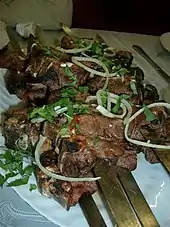Shish kebab
Shish kebab or shish kebap is a popular meal of skewered and grilled cubes of meat.[1] It can be found in Mediterranean cuisine and is similar to or synonymous with dishes called shashlik and khorovats, found in the Caucasus region.[2]

It is one of the many types of kebab, a range of meat dishes originating in the Middle East. In North American English, the word kebab alone often refers to shish kebab, though outside of North America, kebab may also mean doner kebab.
It is traditionally made of lamb[3] but there are also versions with various kinds of meat, poultry, or fish.[4] In Turkey, shish kebab and the vegetables served with it are grilled separately, normally not on the same skewer.[5]
Etymology
Shish kebab is an English rendering of Turkish: şiş (sword or skewer) and kebap (roasted meat dish), that dates from around the beginning of the 20th century.[6][7] According to the Oxford English Dictionary, its earliest known publication in English is in the 1914 novel Our Mr. Wrenn by Sinclair Lewis.[6][8]
The word kebab alone was already present in English by the late 17th century, from the Arabic: كَبَاب (kabāb), partly through Urdu, Persian and Turkish.[9] Etymologist Sevan Nişanyan states that the word has the equivalent meaning of "frying/burning" with "kabābu" in the old Akkadian language, and "kbabā/כבבא" in Aramaic.[10] The oldest known example of şiş, probably originally meaning a pointed stick, comes from the 11th-century Dīwān Lughāt al-Turk, attributed to Mahmud of Kashgar.[11][12]
Gallery
 Shish kebab
Shish kebab Shish kebab in Ankara
Shish kebab in Ankara Lamb shish
Lamb shish Armenian khorovats
Armenian khorovats
See also
References
- John Ayto (18 October 2012). The Diner's Dictionary: Word Origins of Food and Drink. OUP Oxford. pp. 192–. ISBN 978-0-19-964024-9.
- Davidson, Allen, "The Oxford Companion to Food", p.442.
- Ozcan Ozan (13 December 2013). The Sultan's Kitchen: A Turkish Cookbook. Tuttle Publishing. pp. 146–. ISBN 978-1-4629-0639-0.
- Mimi Sheraton (13 January 2015). 1,000 Foods To Eat Before You Die: A Food Lover's Life List. Workman Publishing Company. pp. 1090–. ISBN 978-0-7611-8306-8.
- Steven Raichlen (28 May 2008). The Barbecue! Bible 10th Anniversary Edition. Workman Publishing Company. pp. 214–. ISBN 978-0-7611-5957-5.
- "shish kebab". Oxford English Dictionary (2nd ed.). Oxford University Press. 1989.
- Marks, Gil (17 November 2010). Encyclopedia of Jewish Food. HMH. ISBN 9780544186316 – via Google Books.
- Lewis, Sinclair (11 March 2015). Our Mr. Wrenn – The Romantic Adventures of a Gentle Man. Read Books Ltd. ISBN 9781473372498 – via Google Books.
- "kebab - definition of kebab in English". Oxford Dictionaries. Oxford University Press. Archived from the original on August 3, 2017. Retrieved August 3, 2017.
- Nişanyan Sevan, Sözlerin Soyağacı, Çağdaş Türkçenin Etimolojik Sözlüğü, Online, Book Archived 2013-07-03 at the Wayback Machine
- Perry, Charles (1996). "The Horseback Kitchen of Central Asia". Food on the Move. Oxford Symposium on Food and Cookery. p. 244. ISBN 9780907325796. Retrieved 2018-07-16.
- "Nişanyan Sözlük - şiş" [Nişanyan Dictionary - shish]. Nişanyan Sözlük (in Turkish). Retrieved 2018-07-16.
